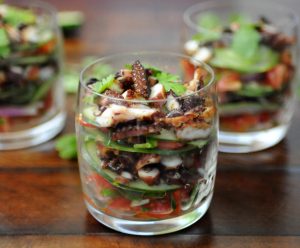Putting Octopus on Your Holiday Menu
If your celebrating the Feast of Seven Fishes, or just want to serve more seafood this holiday season, you’re probably thinking of preparing an eight legged creature in some way shape or form. Whether you’re making a pasta dish, salad, or appetizer, Samuels is here to help you maximize flavor and yield.
So, how do you create an Octopus dish for your holiday menu, without breaking the bank? There’s two answers here. First, optimize your yield and second, pair your dish with something that weighs more after you cook it like beans, rice, or pasta.
Cooking this beast whole, first, will be the best way to minimize food costs. Much like a pork butt, there’s a lot of tissue and collagen that needs to be broken down – and this requires time.
There are four cooking methods that we’re going to focus on: sous vide, confit, steaming, and poaching. After you complete these procedures, you can go on to either roasting, grilling, pan searing, or frying. But, this will be your launching point.
For sous vide, we go with Thomas Keller’s method. The ideal temp is 77 Celsius (170.6F) for 5 hours. Cooking for this length of time will be the best way to infuse flavor, and keep the tentacles intact. This is the most controlled environment.
Confit is another popular way of cooking Octopus. Since more flavors are easily absorbed into fat, this method has the potential of being the most flavorful. Place in the oven, covered at 190F for at least two hours. You can also save this oil for future cooking. The more you use it, the deeper the flavor becomes.
The method that’s probably the most used is poaching. We suggest poaching for 45 minutes to an hour per pound. You’ll know when it’s done when you can stick a fork in it. You should be able to lift the Octopus up slightly, but then have it slide back into the liquid easily.
 Lastly, you can simply place the whole Octopus in a hotel pan or Dutch oven with salt and pepper and “bake,” covered in the oven at 200F for 2-3 hours. Again, doneness should be determined by a fork test and is completely up to you.
Lastly, you can simply place the whole Octopus in a hotel pan or Dutch oven with salt and pepper and “bake,” covered in the oven at 200F for 2-3 hours. Again, doneness should be determined by a fork test and is completely up to you.
If the suckers keep falling off, it’s because you’re cooking it too long. Try reducing the cooking time by 15 minutes on your next batch. If you’re still experiencing the same issue, wrap the Octopus in cheese cloth like a ball. The less movement it has in the liquid – the better.
Once you’ve removed the legs of your Octopus, you’re left with a gelatinous oddly shaped object known as the hood. This is completely edible. If you’re making a salad, terrine, or pasta, you can simply julienne it and toss it in. No one will notice.
Last, but not least, if you cooked it in the oven, or sous vide, you’re left with a delicious liquid. You can reduce this with a sweetener to create a glaze, as an ingredient in a vinaigrette, and even putting some in your pasta water will dye the color your pasta a purplish pink!







